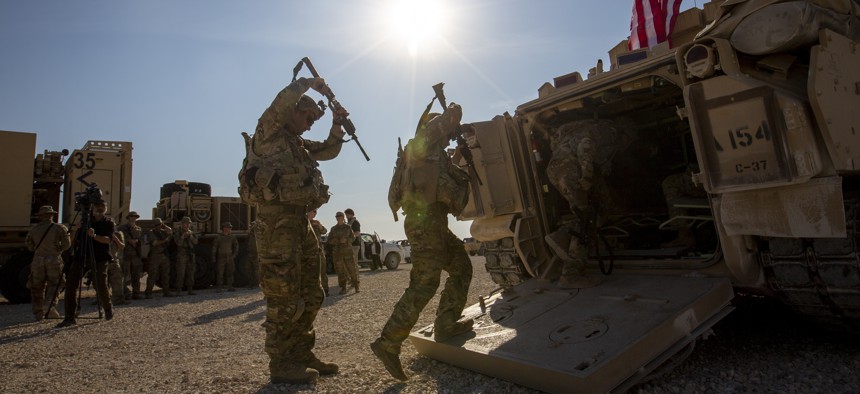
Crewmen enter Bradley fighting vehicles at a US military base in northeastern Syria, Monday, Nov. 11, 2019. AP Photo/Darko Bandic
About 600 US Troops to Remain in Syria, Esper Says
But for what mission? Pentagon chief says Trump’s focus on "keeping" oil is part of fighting ISIS.
SEOUL, South Korea — Around 600 troops will remain in Syria when the restructuring and drawdown of the U.S. mission there is complete, Defense Secretary Mark Esper said.
“All in-country, 600-ish,” Esper, on the way to Seoul, told reporters traveling with him Asia. "’-Ish’ because it changes on a daily basis, people moving in and out, doing different things, and… we're still withdrawing folks from Kobani, and that'll take another week or so, I think.”
That's up from "probably in the 500-ish frame. Maybe 600,” which is what Joint Chiefs Chairman Gen. Mark Milley said on the ABC News program “This Week” on Sunday.
Exactly why those Americans are in Syria has become a new source of debate. Esper said the United States is still partnering with the mainly-Kurdish Syrian Democratic Forces, or SDF, in the counter-ISIS mission. But President Donald Trump has said that the United States is “keeping” oil in Syria.
“We left troops behind only for the oil,” Trump said at the White House on Wednesday, during a state visit by Turkish President Recep Tayyip Erdogan.
Esper on Thursday said those two goals are one and the same; the mission continued to be “the enduring defeat of ISIS,” which was the original stated intention of the U.S. deployment there, and securing Syria’s oil helps achieve that goal.
“A way that we ensure the enduring defeat of ISIS is deny them access to the oil fields because if they have access to the oil fields, they can generate revenue,” he said. “If they can generate revenue, then they can pay fighters, they can buy arms, they can conduct operations. They can do all those things because the revenue enables them. So that's how the mission relates.”
Asked how that translates to the United States “keeping” or “taking” the oil — which legally belongs to the Syrian government, not the SDF — Esper has previously said that the president’s remarks are “half dozen, six.”
“I interpret that as deny ISIS access to the oil fields, secure them,” he said earlier this month.
Trump in October announced a complete U.S. withdrawal from Syria in the midst of a Turkish attack on the U.S.-backed SDF in northeastern Syria. The decision sparked a swift outcry in Washington, even from usually-stalwart allies of the president, who saw it as ceding strategic ground to America’s adversaries in Syria and abandoning the Kurdish partners. Trump later reversed that decision, saying that the U.S. will leave U.S. troops to “secure” the oil — raising legal and practical questions about what, exactly, that means. Reports on the exact number of troops to remain in Syria have fluctuated as officials have continued to grapple behind the scenes with how many troops will remain behind, but Esper this week said reports that U.S. troops in Syria still numbered near 1,000 were inaccurate.
Joint Chiefs Chairman Gen. Mark Milley, who is also in South Korea for meetings this week, said Sunday that the number would be “maybe 600.”
“You've got to be flexible in these situations. Things change. Events on the ground change,” Esper said. “We could have, for example, partners and allies from Europe joining us. If they join us on the ground it may allow us the ability to redeploy further U.S. forces out there.”




